Automotive OTA Research: 3.838 Million Passenger Cars Packed OTA Capability in China in 2019, Soaring by 60.6% Year on Year
Against all odds, controversial Tesla and NIO were eventually out of the woods. What they live on is FOTA (Firmware-over-the-air). Upgrading software and hardware provides new experience for car owners, making them more satisfied and very loyal.
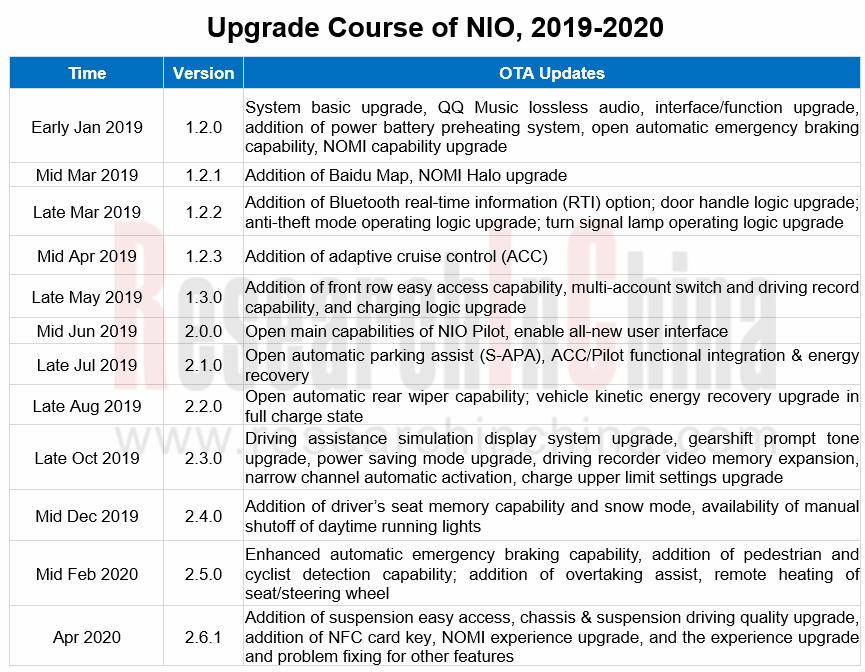
Even nowadays, few vehicle models enable FOTA, really a hard nut to crack.
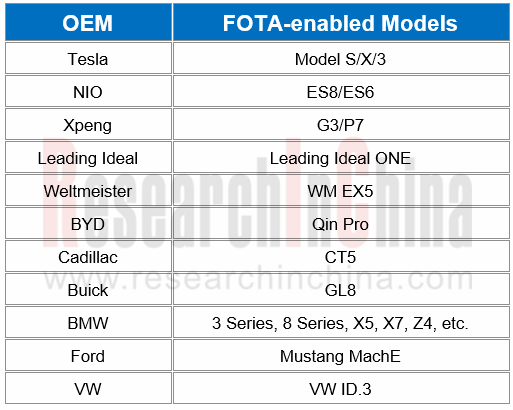
Considering safety and FOTA challenges, traditional automakers mostly choose to tap into vehicle system SOTA (Software-over-the-air) and act prudently in FOTA promotion. Through the lens of a typical FOTA flow, realizing FOTA needs E/E architecture disruption, and the support of new technologies like automotive Ethernet, cyber security, intelligent gateway, great computing power, and large memory.
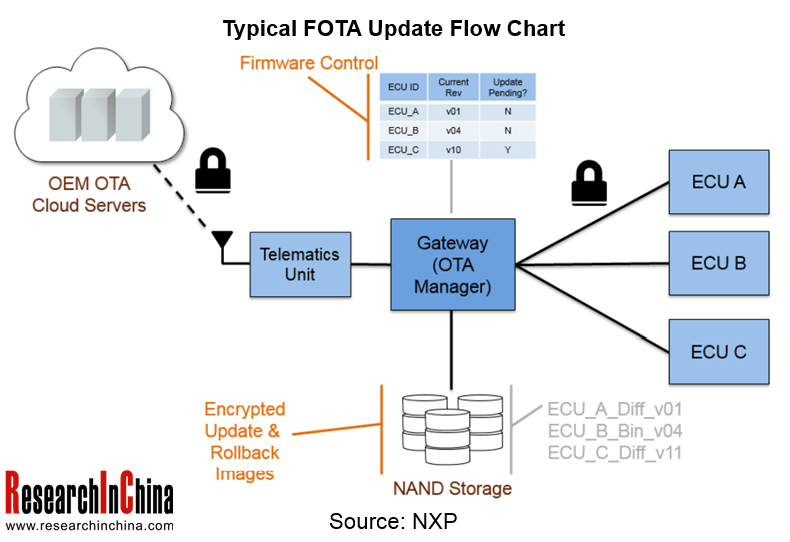
Conventional OEMs have made slow progress in FOTA development over the past several years. Yet they took a big step forward in 2019. It can be seen from the table below that there is a gap between main OEMs and Tesla. Success of Tesla Model 3 weighs so heavily on traditional automakers that they are highly endangered except sweating for rapid transformation.
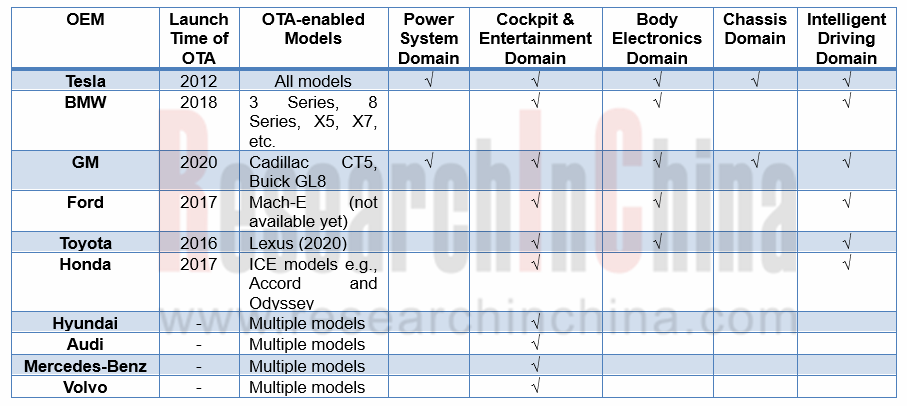
VW is the most aggressive among OEMs, while its counterparts are also working hard. The race to roll out intelligent gateway chip in early 2020 is a reflection of OEM’s eager hoping to enable FOTA as early as possible just as Tesla has done.
Installation of SOTA easier to realize is soaring in both volume and rate. In 2019, 3.838 million passenger cars, or 19% of the total, were provided with SOTA, jumping by 60.6% compared with 2.39 million units, or 11.8% of the total in 2018, according to ResearchInChina.
Among typical OEMs, GM leads in OTA capability. Its new-generation electronic architecture enables FOTA updates on its ICE models, which means OTA is available to recalibrate or upgrade engine and transmission control modules, vehicle communication system, entertainment system, driving control and body control ECU at a later stage.
In 2020, Buick’s latest interconnection system, eConnect3.0 enables OTA updates of 9 major models such as OnStar module, IVI system, intelligent driving control module, body control module, and iBooster brake booster.
In 2020, the latest Cadillac CT5 model will pack GM’s new electronic architecture. CT5 allows OTA updates of more than 30 vehicle control modules including software modules (e.g., IVI and smart connectivity) and firmware electronic modules (e.g., powertrain, chassis and electrical control).
GM plans to apply its next-generation E/E architecture to most of its car lineups before 2023.
Chinese companies that excel in application layer innovation already make plenty of OTA micro-innovations. Examples include SAIC providing personalized OTA -- DOTA, and BYD and XPENG Motors both offering high temperature disinfection capability enabled by OTA updates.
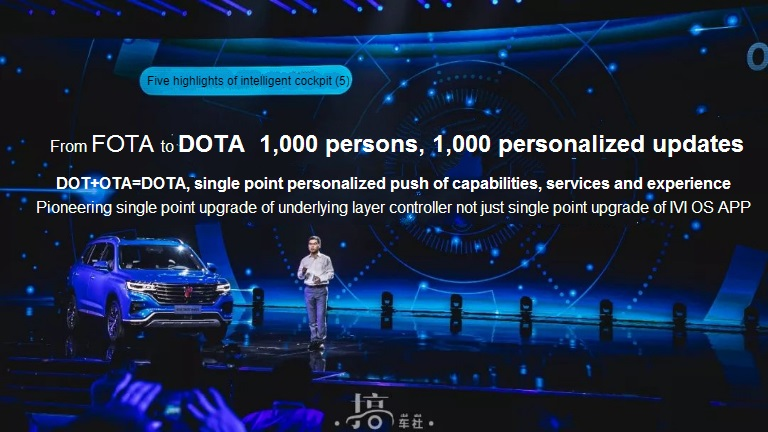
In April 2020, BYD announced its new models like Tang added with “high temperature disinfection capability” enabled by OTA updates. This capability is not simple upgrade and introduction but involves a complete set of OTA-based working logic of multiple ECUs (e.g., multimedia, air-conditioner controller and PTC heater) in a safe way.
Automotive Vision Industry Report, 2025
Automotive Vision Research: Average Camera Installation per Vehicle Reaches 5.2 Units, and Front-View Tricam Installation Exceeds 1.2 Million Sets.
From January to September 2025, the total installa...
Automotive Infrared Night Vision System Research Report, 2025
Automotive night vision research: The rise of infrared AEB, with automotive infrared night vision experiencing a 384.7% year-on-year increase from January to September.
From January to September 2025...
New Energy Vehicle Cross-Domain (Electric Drive System and Powertrain Domain) Integration Trend Report 2025-2026
Electric Drive and Powertrain Domain Research: New technologies such as three-motor four-wheel drive, drive-brake integration, and corner modules are being rapidly installed in vehicles.
Electric dri...
Analysis on Desay SV and Joyson Electronic's Electrification, Connectivity, Intelligence and Sharing, 2025
Research on Desay SV and Joyson Electronic: Who is the No.1 Intelligent Supplier?
Both Desay SV and Joyson Electronic are leading domestic suppliers in automotive intelligence. "Analysis on Desay SV ...
OEMs and Tier 1 Suppliers' Cost Reduction and Efficiency Enhancement Strategy Analysis Report, 2025
ResearchInChina released the "OEMs and Tier 1 Suppliers' Cost Reduction and Efficiency Enhancement Strategy Analysis Report, 2025", summarizing hundreds of cost reduction strategies to provide referen...
Automotive Fixed Panoramic Sunroof and Smart Roof Research Report, 2025
With the intelligent application of car roofs as the core, this report systematically sorts out a series of new products such as fixed panoramic sunroof/openable sunroof, ceiling screen, roof ambient ...
Automotive-Grade Power Semiconductor and Module (SiC, GaN) Industry Research Report, 2025
SiC/GaN Research: Sales volume of 800V+ architecture-based vehicles will increase more than 10 times, and hybrid carbon (SiC+IGBT) power modules are rapidly being deployed in vehicles.
Sales volume o...
Cockpit Agent Engineering Research Report, 2025
Cockpit Agent Engineering Research: Breakthrough from Digital AI to Physical AI
Cockpit Agent Engineering Research Report, 2025 starts with the status quo of cockpit agents, summarizes the technical ...
Prospective Study on L3 Intelligent Driving Technology of OEMs and Tier 1 Suppliers, 2025
L3 Research: The Window of Opportunity Has Arrived - Eight Trends in L3 Layout of OEMs and Tier 1 Suppliers
Through in-depth research on 15 OEMs (including 8 Chinese and 7 foreign OEMs) and 9 Tier 1 ...
China Commercial Vehicle IoV and Intelligent Cockpit Industry Research Report 2025
Commercial Vehicle IoV and Cockpit Research: The Third Wave of Passenger Car/Commercial Vehicle Technology Integration Arrives, and T-Box Integrates e-Call and 15.6-inch for Vehicles
I. The third wav...
Intelligent Vehicle Electronic and Electrical Architecture (EEA) and Technology Supply Chain Construction Strategy Research Report, 2025
E/E Architecture Research: 24 OEMs Deploy Innovative Products from Platform Architectures to Technical Selling Points
According to statistics from ResearchInChina, 802,000 passenger cars with domain...
Research Report on Intelligent Vehicle Cross-Domain Integration Strategies and Innovative Function Scenarios, 2025
Cross-Domain Integration Strategy Research: Automakers' Competition Extends to Cross-Domain Innovative Function Scenarios such as Cockpit-Driving, Powertrain, and Chassis
Cross-domain integration of ...
China Autonomous Driving Data Closed Loop Research Report, 2025
Data Closed-Loop Research: Synthetic Data Accounts for Over 50%, Full-process Automated Toolchain Gradually Implemented
Key Points:From 2023 to 2025, the proportion of synthetic data increased from 2...
Automotive Glass and Smart Glass Research Report, 2025
Automotive Glass Report: Dimmable Glass Offers Active Mode, Penetration Rate Expected to Reach 10% by 2030
ResearchInChina releases the Automotive Glass and Smart Glass Research Report, 2025. This r...
Passenger Car Brake-by-Wire (BBW) Research Report, 2025
Brake-by-Wire: EHB to Be Installed in 12 Million Vehicles in 2025
1. EHB Have Been Installed in over 10 Million Vehicles, A Figure to Hit 12 Million in 2025.
In 2024, the brake-by-wire, Electro-Hydr...
Autonomous Driving Domain Controller and Central Computing Unit (CCU) Industry Report, 2025
Research on Autonomous Driving Domain Controllers: Monthly Penetration Rate Exceeded 30% for the First Time, and 700T+ Ultrahigh-compute Domain Controller Products Are Rapidly Installed in Vehicles
L...
China Automotive Lighting and Ambient Lighting System Research Report, 2025
Automotive Lighting System Research: In 2025H1, Autonomous Driving System (ADS) Marker Lamps Saw an 11-Fold Year-on-Year Growth and the Installation Rate of Automotive LED Lighting Approached 90...
Ecological Domain and Automotive Hardware Expansion Research Report, 2025
ResearchInChina has released the Ecological Domain and Automotive Hardware Expansion Research Report, 2025, which delves into the application of various automotive extended hardware, supplier ecologic...